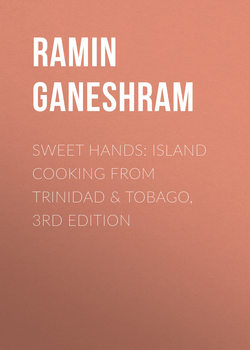Читать книгу Sweet Hands: Island Cooking from Trinidad & Tobago, 3rd edition - Ramin Ganeshram - Страница 11
ОглавлениеTo understand your taste is to appreciate not only what, among other things, distinguishes you from others, but to appreciate the history of flavors that proceeded you, the places your ancestors lived, the households they built, the meals they made.
Families from all corners of the earth are, after all, rift with stories of unexplained habits and food preferences. The six-pronged candlestick to which the Catholic farm wife in Nebraska religiously adds a candle each night in the six days before Christmas turns out to have traveled from a Jewish ghetto in Warsaw to the Midwestern plains. The “family secret” of cutting a pot roast in half and cooking it in two vessels becomes, upon investigation, less about the quality of the dish and more about the fact that a great-great-grandmother did not have a pot large enough to contain the meat.
Habits of the kitchen and the table are not only shaped by ethnic heritage, religious tradition, and financial necessity, they are also sculpted by place. The presence, say, of tomatoes in a Louisiana gumbo says that somewhere along the line the Cajun dish spent time among the Creoles of New Orleans. A wild profusion of meat and herbs in Vietnamese pho is a good indication that the meager beef broth of Hanoi has seen more than a little of Saigon.
The great-granddaughter of an east Indian indentured laborer and Hindu priest, Ramin Ganeshram may not have set out to tease apart the various strands of her own culinary DNA. The Manhattan-born journalist and chef meant to gather and record the recipes of Trinidad & Tobago, her father’s homeland. It was a sorely needed task. Her father and Iranian mother lived, she writes, “a life of substitution” after emigrating to New York, and like many ethnically complicated cultures, the dishes of these two Caribbean islands are traditionally passed from mother to daughter and little is written down. But when she returned to the islands where she’d spent the summers of her youth, gathering recipes quickly became an exercise in gathering lost parts of herself and understanding where she came from, who she is, and what she likes to eat.
The result is the first cookbook that teaches the home cooking of these islands in clear, concise recipes. It is also a journey through a dramatic, mountainous spot that has been sculpted by water and wind, as well as by a succession of “overlords.” After being spotted by Christopher Columbus, Dutch rule gave way to French rule and that in turn bowed to British rule. And then there were the peoples who were imported from Africa, China, and east India specifically to be indentured to an overlord’s cocoa and sugarcane plantations.
At a gentle, all but lyrical pace, Ganeshram has used family stories, snippets of history, lush descriptions, and ambles through village markets, past roadside vendors, to spots like the “Breakfast Shed” and other well off-the-beaten-tourist-path places to lead the reader to the quiet discovery of this beautiful spot where “east” has been meeting “west” day after day for centuries. As I read how to brighten a winter squash soup with coconut and to make a fine shrimp patty and to rethink my relationship with rice, tropical fruits, and plantains, my hands itched to cook—it was difficult to keep my seat.
I like to think that my agitation was a sign of metamorphosis. In Trinidad & Tobago, good cooks may not share a religion, an ethnicity, or the same social status, but they all have magical hands, hands capable of keeping this bright, complicated melting pot of a cuisine simmering, shifting, and vibrantly alive—sweet hands.
—Molly O’Neill
